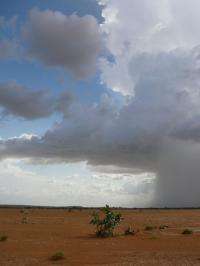Initiation of a storm in a semi-desert area in Mali during the monsoon. © F. Guichard
In the Sahel, the frequency of storms increases when soil moisture varies over a few kilometers. Such contrasts cause air circulation between dry and humid areas, contributing to the development of storms. For the first time, these contrasts have been studied on a small scale by a collaboration between French researchers from the Groupe d'Etude de l'Atmosphere Meteorologique (CNRS) and UK researchers from CEH, as part of the AMMA project. Their findings, published in the July 2011 issue of Nature Geoscience, provide new data that should help to address the issue of drought in the Sahel.
The Sahel is a semi-arid tropical region where annual rainfall depends on a few dozen storms that form during the monsoon season. The number of storms is therefore crucial in this region of the world, where insufficient precipitation can lead to a year of drought. Intense rainfall during these storms causes marked contrasts with neighboring areas in terms of humidity and temperature. Such contrasts play a role in the stability of the lower layers of the atmosphere. French and UK researchers focused on the potential connections between storm formation and variations in soil properties caused by rainfall in the preceding days. They developed a statistical approach to perform individual, daytime analysis of several thousand cases of storm development identified by satellite observations at high spatial and temporal resolution during five monsoon seasons.
Simplified diagram of positive feedback. In the lower layers of the atmosphere, a breeze (thin arrow on the right) starts to blow from the cold, moist area towards the warm, dry area. When this breeze blows in the opposite direction to the wind (left-hand arrow), rising air (grey arrow) favors storm formation. © A. Gounou
They found that, at the 100-km scale, storms develop more frequently above the driest and hottest surfaces. Series of satellite observations of surface temperatures at high spatial resolution (3 kilometers) were used to estimate variations in soil moisture at scales of a few tens of kilometers. The results obtained show that the number of storms significantly increases over surfaces with high contrasts in soil moisture, and more specifically in transitional areas where winds blow from a dry area towards a humid area. This suggests that atmospheric circulation starts up in the opposite direction to the wind, blowing from the more humid areas towards the drier areas, thus facilitating the formation of storms. Meteorological analyses have shown that this type of pattern is especially pronounced when the atmospheric environment is unfavorable to storms. Such contrasts therefore play a significant role in storm formation in the Sahel.
This is the first time that a study has shown, on the basis of observations, a positive feedback mechanism at this scale, namely preferential initiation of storms in areas with high soil moisture contrasts caused by intense localized rainfall. These findings shed a new light on the role of surface/atmosphere interactions in the mechanisms of storm formation and provide data that should help to address drought issues in the Sahel. The climate sensitivity of such interactions remains to be explored since current studies do not yet take it into account.
More information: Frequency of Sahelian storm initiation enhanced over mesoscale soil moisture patterns, Christopher M. Taylor, Amanda Gounou, Françoise Guichard, Phil P. Harris, Richard J. Ellis, Fleur Couvreux, Martin De Kauwe, Nature Geoscience, 01 July 2011. DOI: 10.1038/NGEO1173
Provided by CNRS





















